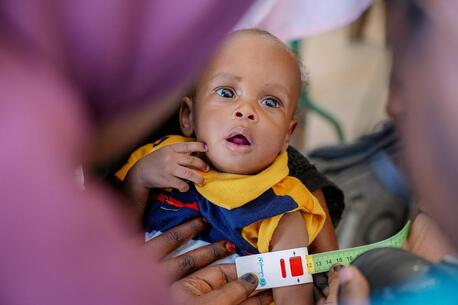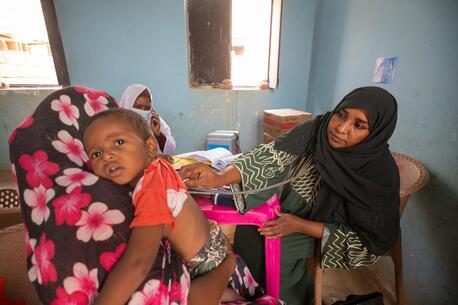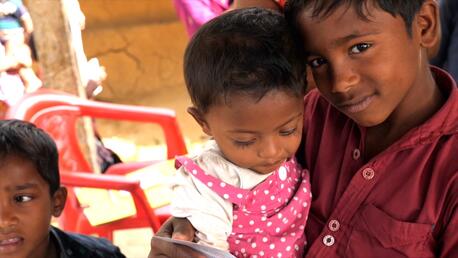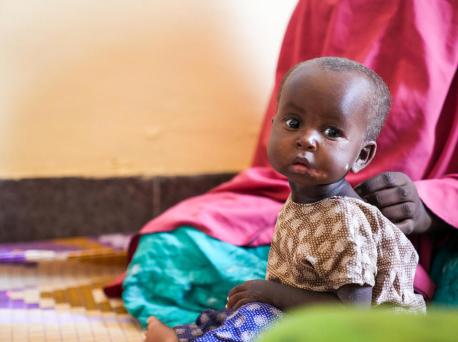
UNICEF Calls on G7 to Help Tackle Global Child Malnutrition Crisis
A child every minute — that's how quickly the number of children suffering from severe wasting has been rising due to the current global food crisis. With millions of young lives at risk in 15 countries, UNICEF issues an urgent appeal for support to ramp up emergency lifesaving interventions.
Almost 8 million children under age 5 in 15 countries — from Afghanistan to Yemen, Burkina Faso to Somalia — are at risk of death from severe wasting unless they receive immediate therapeutic food and care, UNICEF warned as world leaders prepared to meet for the next G7 summit.
UNICEF has issued an urgent appeal for $1.2 billion to deliver lifesaving treatment to severely wasted children and to accelerate the rollout of other cost-effective solutions in areas hardest hit by the current global food crisis, which include several countries in the Horn of Africa and in Africa's Sahel region.
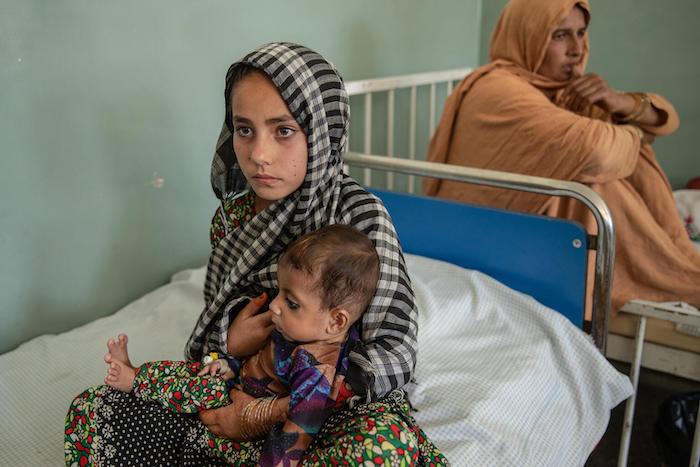
On May 7, 2022, Zarghoneh, 9, cradles her baby brother at Kunar Central Hospital, Afghanistan, where he is being treated for severe acute malnutrition with support from UNICEF. In Kunar and in other provinces, UNICEF provides therapeutic foods to clinics and mobile health teams, trains health care workers and provides screening and monitoring equipment. A deadly earthquake that struck Paktika and Khost provinces on June 22 has only intensified humanitarian needs in the country. © UNICEF/UN0659443/Bidel
“Food aid is critical, but we cannot save starving children with bags of wheat," UNICEF Executive Director Catherine Russell said. "We need to reach these children now with therapeutic treatment before it is too late.”
Food aid is critical, but we cannot save starving children with bags of wheat. We need to reach these children now with therapeutic treatment before it is too late. — UNICEF Executive Director Catherine Russell
There are a number of factors contributing to growing food and nutrition insecurity worldwide: Soaring food prices driven by the war in Ukraine; persistent drought due to climate change in some countries; regional, civil and inter-communal conflicts; the ongoing economic impacts of COVID-19.
Between January and June of this year, the number of severely malnourished children grew at a rate of one child every minute.*
In response, UNICEF has already been scaling up nutrition interventions with partners in Afghanistan, Burkina Faso, Chad, the Democratic Republic of the Congo, Ethiopia, Haiti, Kenya, Madagascar, Mali, Niger, Nigeria, Somalia, South Sudan, Sudan and Yemen. But more support is urgently needed to avert child deaths in the short term — and to rapidly and sustainably improve nutrition for children globally over the long term.
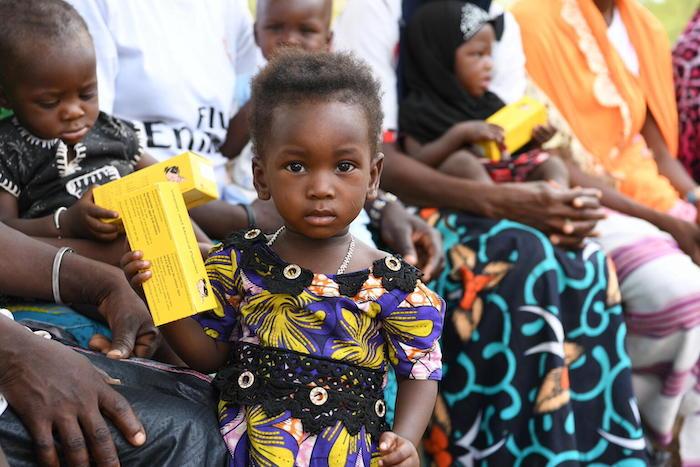
A child holds a box of micronutrient powders at a malnutrition screening session in the village of Ngolo, in the northern region of Burkina Faso, one of many countries in Africa's Central Sahel region deeply affected by the global food crisis. UNICEF and partners distribute the supplements and demonstrate to mothers how to prepare enriched porridge as part of their ongoing programming aimed at preventing malnutrition in communities where children are at high risk. © UNICEF/UN0640850/Dejongh
Improving nutrition for at-risk children avoids long-term damage that severe wasting – where children are too thin for their height – can cause. Well-nourished children are healthier overall, and better able to reach their full potential; undernutrition weakens immune systems, leaving children more susceptible to disease, and at significantly higher risk of death from illness compared to well-nourished children.
Within the 15 focus countries, UNICEF estimates that in addition to the 8 million severely wasted children, there are at least 40 million children who are severely nutrition insecure — meaning they are not receiving the bare minimum diverse diet they need to grow and develop in early childhood — and 21 million children severely food insecure, meaning they lack access to enough food to meet minimum food needs, leaving them at high risk of severe wasting.
Meanwhile, the price of Ready-to-Use Therapeutic Food (RUTF) — a highly effective treatment for severe wasting — has soared by 16 percent in recent weeks due to a sharp rise in the cost of raw ingredients, leaving up to 600,000 additional children without access.
UNICEF to world leaders: 'a small window of opportunity to act'
UNICEF estimates that $1.2 billion is needed to sufficiently support short-term crisis response measures, as well as medium-term stabilization efforts and long-term structural changes. The appeal emphasizes the benefits of fast and flexible funding as a way to help expedite the response.
“It is hard to describe what it means for a child to be ‘severely wasted,’ but when you meet a child who is suffering from this most lethal form of malnutrition, you understand – and you never forget,” Russell said.
“World leaders gathering in Germany for the G7 Ministerial have a small window of opportunity to act to save these children’s lives. There is no time to waste. Waiting for famine to be declared is waiting for children to die.”
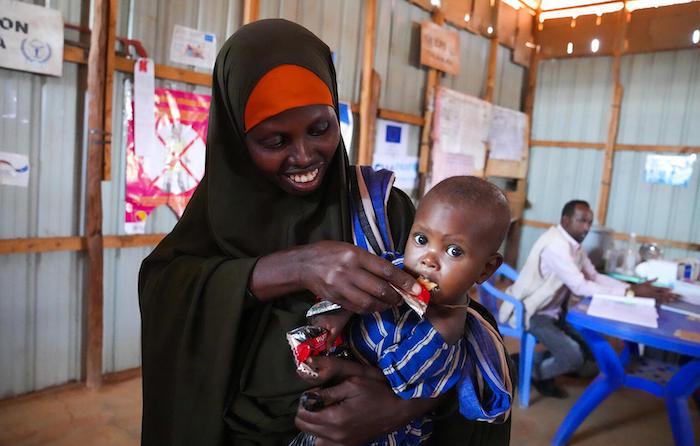
On May 24, 2022, 10-month-old Ubah is fed RUTF (Ready-to-Use Therapeutic Food) by her mother at Dollow Health Center in Somalia. Four consecutive failed rainy seasons have left over 29 million people in Somalia, Ethiopia and Kenya in need of urgent humanitarian assistance in 2022, including at least 1.7 million severely wasted children who require immediate lifesaving support. In Somalia alone, there are at least 330,000 children in urgent need of treatment for severe wasting – well above the 190,000 who required treatment during the country’s 2011 famine. © UNICEF/UN0644320/Fazel
Some of the many ways UNICEF already works with partners to combat child malnutrition — and is looking to ramp up in response to the escalating global food crisis — include:
- supporting early detection and treatment of child wasting
- supplying RUTF, a highly effective treatment for acute cases
- addressing micronutrient deficiencies and anemia by providing multiple micronutrient supplements, Vitamin A supplements, deworming, home-based fortification and malaria control measures
- supporting early initiation of exclusive and continued breastfeeding
- supporting maternal nutrition and balanced protein-energy supplements for undernourished women
- providing age-appropriate, diverse complementary foods with food-based supplements – including lipid-based nutrient supplements – for undernourished children
- enhancing social protections for households at risk of falling into extreme poverty and becoming food insecure
- providing emergency cash transfers or vouchers to households in the most severely affected countries
- helping to finance system-level improvements focused on increasing food availability and ensuring affordability of nutritious foods
Good nutrition saves lives, yet in the midst of a hunger crisis the nutrition response risks being sidelined — with catastrophic consequences. Fifty million children under age 5 are estimated to be acutely malnourished this year, and a further 150 million risk lifelong impacts of child stunting. Help UNICEF accelerate nutrition support for at-risk children. Donate today.
Top photo: On May 25, 2022, 10-month-old Marwo sits with her mother at Banadir Hospital in Mogadishu, Somalia. Marwo was successfully treated for diarrhea and severe acute malnutrition at a UNICEF-supported stabilization center, where she received therapeutic formulas and round-the-clock medical care. Her swollen right cheek is a result of nasogastric feeding. © UNICEF/UN0644292/Fazel
*The rate of increase in child wasting is based on publicly-available estimates for January and June 2022 as found in National Nutrition Cluster estimates (Burkina Faso, Chad, Mali, Niger, Nigeria and DRC), Integrated Phase Classification Acute Malnutrition Analyses (Kenya, Somalia, South Sudan, Yemen, Madagascar and Haiti), Humanitarian Appeals for Children (Ethiopia, Afghanistan), and Humanitarian Needs Overviews (Sudan). The total number of children projected to suffer from severe wasting in January and June 2022 was estimated to be 7,674,098 and 7,934,357 respectively, an increase of 260,259 additional children.
HOW TO HELP
There are many ways to make a difference
War, famine, poverty, natural disasters — threats to the world's children keep coming. But UNICEF won't stop working to keep children healthy and safe.
UNICEF works in over 190 countries and territories — more places than any other children's organization. UNICEF has the world's largest humanitarian warehouse and, when disaster strikes, can get supplies almost anywhere within 72 hours. Constantly innovating, always advocating for a better world for children, UNICEF works to ensure that every child can grow up healthy, educated, protected and respected.
Would you like to help give all children the opportunity to reach their full potential? There are many ways to get involved.



